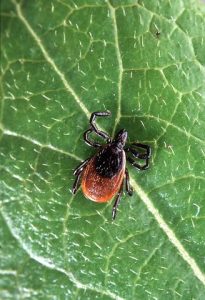
What would you think if you saw a group of people dressed head to foot in white Tyvek coveralls, walking through the woods dragging white blankets?
“One woman asked me if I was trying to fly a kite,” says PhD student Katie Clow. “That would have to be the least efficient way possible to fly a kite! And sometimes people think there has been a biohazard spill that we are trying to clean up.”
What Clow and her assistants are actually doing is dragging for ticks.
This year they hope to visit 110 sites across Ontario, stretching from Windsor to Cornwall to Sault Ste. Marie. The team suits up, heads into the woods and drags light flannel blankets across the low-growing vegetation for three minutes. The blankets are then checked for any ticks that might have been picked up, and the dragging process is repeated until the team reaches a total of three person-hours of dragging.
“We are looking for all life stages of the ticks,” says Clow, “from the larvae to the nymph stage and then the adults.” The nymph stage can be the most risky for humans because the ticks in this form are so tiny – the size of a poppy seed — that people may not notice them, but they can still transmit Lyme disease.
Adult ticks are also a risk, and the population of adult ticks is at its highest in the fall. Once there is a hard frost and sustained cold weather, the ticks become less active and stay under the leaf litter on the forest floor. If the weather warms up for a few days, though, the ticks could re-emerge. And if the adult females get a good blood meal, they will come back in the spring ready to lay eggs.
Climate change one cause for tick increase in Ontario

Clow graduated from the Ontario Veterinary College with her DVM in 2011 and then worked in private practice in Renfrew, Ont., where she often saw dogs with Lyme disease at the clinic. At the time, that area was not known to have black-legged ticks, and the dogs had no travel history. Seeing the spread of the disease first-hand helped spark her interest in this area of research when she returned to campus to work on her PhD in pathobiology with Prof. Claire Jardine.
“We want to look at the ecology of Lyme disease,” Clow says. “What elements of temperature, precipitation, elevation, et cetera need to be present? What vegetation and animals create the right environment? If we can better understand how the ticks spread and become established, we can better predict the future spread of Lyme disease.”
She adds that evidence suggests that climate change is one cause of the increase in ticks in southern Ontario, but that may not be the only factor.
The results of her research are preliminary, as the ticks collected have been sent to a lab to confirm their species and test for the bacterium Borrelia burgdorferi, which causes Lyme disease. Clow says they discovered ticks farther north than expected, which suggests the bugs are continuing to spread in Ontario.
Lyme disease is caused by bacteria carried by white-footed mice and other small rodents that the larval and nymphal ticks prefer to feed on. If the tick picks up the bacteria from a mouse and then in the next life stage feeds on a deer, there is no problem: deer don’t carry the bacteria or get sick from it. However, if the tick is picked up by a dog or a human, the tick can transmit the bacteria by feeding on its new host.
“Most dogs who test positive for Lyme disease have no symptoms,” explains Clow. “However, when people get it they can be quite sick.”
But don’t panic. It’s not as easy to get Lyme disease as you might think. First, the tick has to carry the infectious bacteria. Researchers have found that even in areas where ticks are known to live, only about 25 per cent carry the Lyme disease bacteria.
Secondly, the tick has to get access to you and your skin. Clow says that if you stay on the path in the woods, wear light-coloured long-sleeved shirts and long pants, and use an insect repellent containing DEET, you will reduce your risk.
After your walk, have someone check you all over for ticks (they especially like to hide in places such as your hairline, your underarms and your private parts) and take a warm shower. The water won’t remove a tick that is attached to your skin, but it will help wash away any that haven’t yet found a spot to bite.
And third, the tick has to feed for at least 24 hours before it can transmit the Lyme disease bacteria, so you have time to find and remove the tick.
Since she’s well aware of the risks, Clow feels quite safe being out in the woods and enjoying nature. But there are other hazards: “Sometimes when I close my eyes at night to go to sleep after a long day of fieldwork, all I can see are ticks — ticks everywhere.”
In her next phase of field studies in 2015, she and her team will look for white-footed mice and other small mammals, take blood samples to be tested for the bacteria and collect data on the deer population.
Once her research is completed and her PhD in hand, Clow hopes to continue her career in academia and follow both her passions: research and teaching.